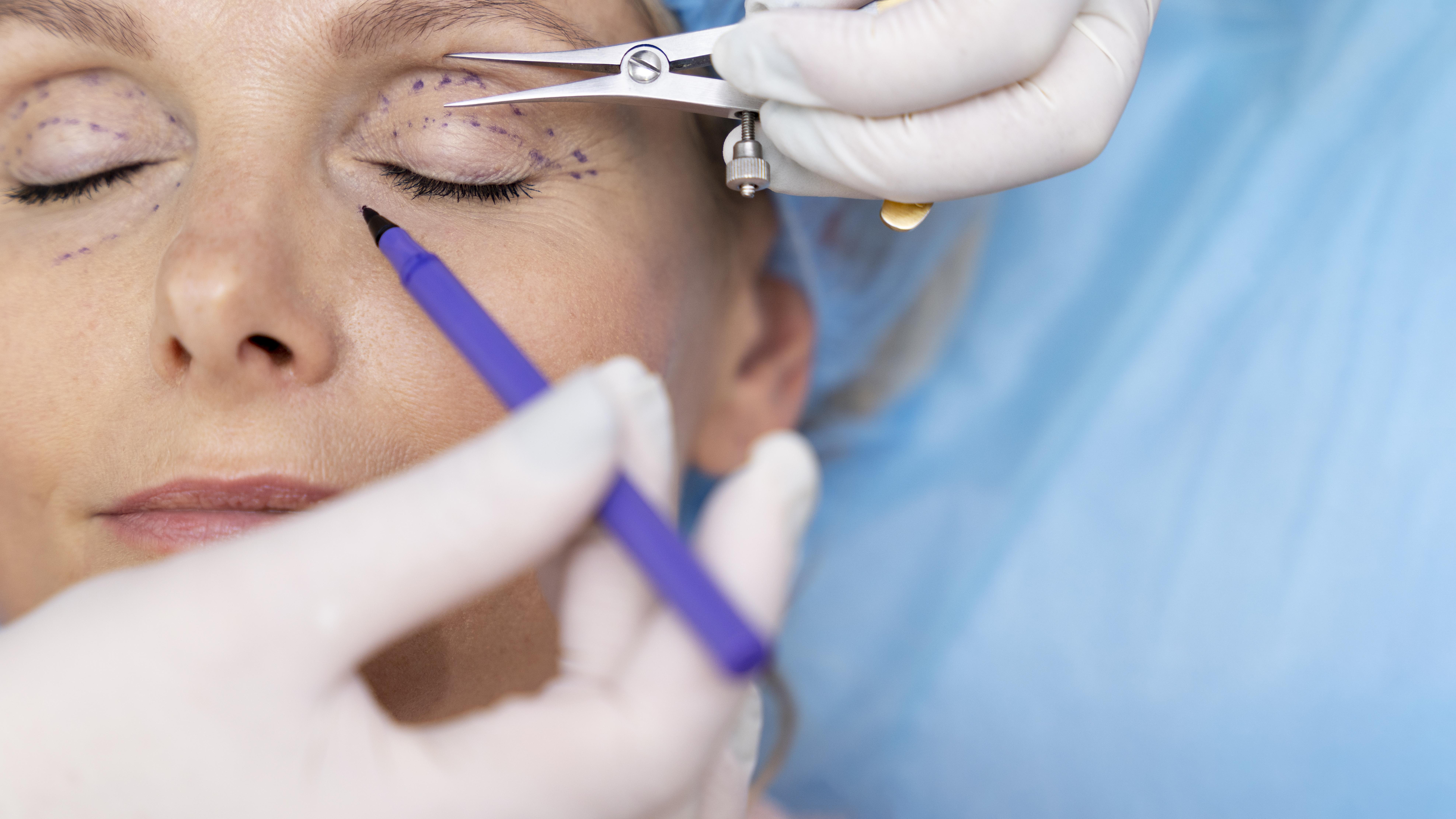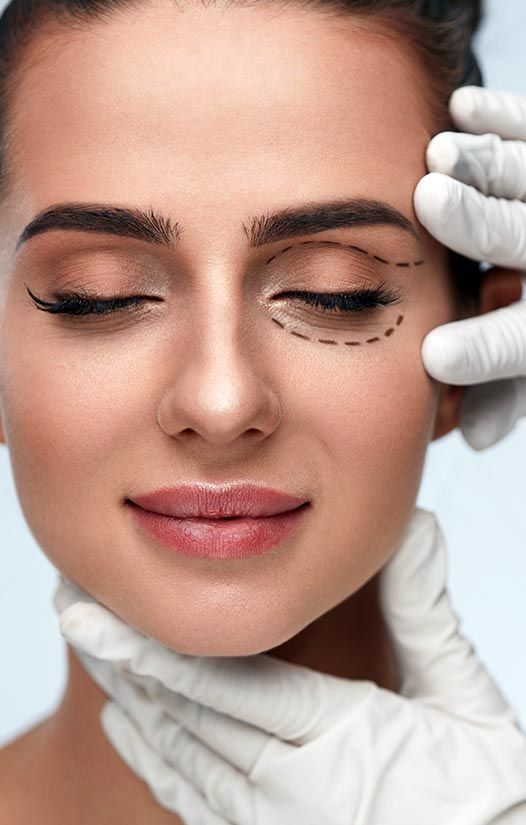Blepharoplasty is a surgical procedure that removes excess skin, muscle, and fat from the upper and lower eyelids. This surgery can improve vision in older individuals who have sagging upper eyelids that obstruct their sight.
Additionally, it can give the eyes a more open and alert appearance, which can significantly enhance one's overall facial aesthetics.

.svg)
For those not ready to undergo surgery, there are non-surgical alternatives that can offer temporary solutions to eyelid concerns. These include treatments such as laser skin resurfacing, which can tighten the skin around the eyes and reduce fine lines, and injectable fillers, which can help to fill in hollow areas and reduce the appearance of under-eye bags. While these options are less invasive, they do not provide the long-lasting results that blepharoplasty offers.
On the day of your blepharoplasty, you can expect the procedure to be relatively straightforward. Typically performed on an outpatient basis, the surgery involves local anesthesia with sedation or general anesthesia, depending on the extent of the surgery and patient preference. The entire procedure usually takes between one to three hours, based on whether both upper and lower eyelids are being addressed. Post-surgery, you will be monitored for a short period before being allowed to go home to recover.
Proper preparation is crucial for a successful blepharoplasty outcome. During the preoperative consultation, your surgeon will provide detailed instructions on how to prepare for the surgery. This may include avoiding certain medications that can increase bleeding risk, arranging for someone to drive you home after the procedure, and setting up a comfortable recovery area at home. It's also recommended to stop smoking well in advance of the surgery to promote better healing.
After your blepharoplasty, adhering to the post-operative care guidelines provided by your surgeon is essential for a smooth recovery. Applying cold compresses can help reduce swelling and bruising, and keeping your head elevated while sleeping can aid in faster healing. Avoid strenuous activities and protect your eyes from sun exposure by wearing sunglasses. Follow-up appointments will be scheduled to monitor your healing progress and address any concerns.
While blepharoplasty offers long-lasting results, it's important to have realistic expectations about the aging process. The procedure can dramatically improve the appearance of your eyelids, making you look more youthful and refreshed, but it doesn't stop the natural aging process. Maintaining a healthy lifestyle, protecting your skin from sun damage, and possibly combining your blepharoplasty with other cosmetic treatments in the future can help prolong and enhance your results.

Selecting a qualified and experienced surgeon is crucial for achieving optimal results from your blepharoplasty. A board-certified plastic surgeon or oculoplastic surgeon specializing in eyelid surgeries will have the necessary expertise and skill to perform the procedure safely and effectively. During your consultation, ask about the surgeon's experience, view before-and-after photos of previous patients, and read reviews or testimonials to gauge their track record. A thorough discussion about your goals and concerns will help ensure that the surgeon understands your expectations and can tailor the surgery to meet your needs.
Blepharoplasty can be combined with other facial rejuvenation procedures for more comprehensive results. For instance, a brow lift can address sagging brows and forehead lines, complementing the effects of an upper eyelid lift. Similarly, a facelift can tighten the skin and muscles of the lower face and neck, providing a more youthful overall appearance. Non-surgical treatments such as Botox or dermal fillers can also be used in conjunction with blepharoplasty to smooth wrinkles and restore volume to the face, enhancing the overall outcome.
Beyond the physical improvements, blepharoplasty can have a significant positive impact on your mental and emotional well-being. Many patients report feeling more confident and satisfied with their appearance after the procedure. This boost in self-esteem can translate to improved social interactions, professional opportunities, and overall quality of life. It's important to have realistic expectations and understand that while blepharoplasty can enhance your appearance, it is not a cure-all for self-esteem issues.
Proper eye care post-surgery is essential to ensure a smooth recovery and the best possible results. In addition to following your surgeon's instructions, consider using lubricating eye drops to alleviate dryness and discomfort. Avoid activities that can strain your eyes, such as reading or using electronic devices for prolonged periods. Wearing sunglasses when outdoors will protect your healing eyes from wind, dust, and sunlight. If you experience any unusual symptoms, such as severe pain, vision changes, or signs of infection, contact your surgeon immediately.
To maintain the results of your blepharoplasty, it's important to adopt a long-term skincare routine and follow up with your surgeon as recommended. Use high-quality skincare products that are gentle on the eye area and provide adequate hydration and sun protection. Regular follow-up appointments will allow your surgeon to monitor your progress and address any concerns. If needed, additional treatments or touch-ups can be performed to sustain and enhance your results over time.
There are several techniques used in blepharoplasty, each tailored to address specific concerns.
An upper eyelid lift targets the excess skin and fat in the upper eyelids. This technique is ideal for individuals with droopy or hooded eyelids that can make them look tired or older than they are.
The surgeon makes an incision along the natural crease of the upper eyelid, removing excess skin, muscle, and sometimes fat. The incision is then closed with fine sutures, leaving minimal visible scarring.
A lower eyelid lift focuses on removing or repositioning fat deposits and tightening loose skin to reduce puffiness and under-eye bags.
The incision for a lower eyelid lift is typically made just below the lower lash line. The surgeon then removes or repositions fat, tightens muscles, and trims excess skin before closing the incision.
For individuals with concerns about both upper and lower eyelids, a combined surgery can be performed. This approach addresses both sets of eyelids in one surgical session, providing comprehensive rejuvenation.
This technique is used primarily for lower eyelid surgery and involves making an incision inside the lower eyelid, leaving no visible scars. It’s particularly useful for patients who need fat removed or repositioned but do not have significant skin sagging.
Blepharoplasty is suitable for individuals who are generally healthy and have realistic expectations about the results. Common candidates include those with:
Excess skin obscuring the natural fold of the upper eyelids
Loose upper eyelid skin that impairs vision
Puffiness in the upper eyelids
Bags under the eyes
Droopy lower eyelids showing white below the iris
Recovery from blepharoplasty typically involves some swelling and bruising, which can last for a few weeks. Most patients can return to work and normal activities within 10 to 14 days. It's important to follow the surgeon's post-operative care instructions to ensure proper healing.
The results of blepharoplasty can last for many years. While the aging process will continue, most patients find that their eyes look younger and more refreshed for a long time after the procedure.
During a consultation, the surgeon will evaluate your medical history, discuss your goals, and perform a physical examination of your eyes. They will also explain the procedure, potential risks, and expected outcomes to help you make an informed decision.
Our non-surgical eyelid lift uses advanced technologies such as radiofrequency (RF) and ultrasound therapy to tighten and lift the skin around the eyes. This treatment stimulates collagen production, resulting in firmer, more youthful-looking eyelids without the need for surgery.
Dermal fillers can be strategically injected to add volume and reduce the appearance of hollow or sagging eyelids. This minimally invasive procedure helps to create a smoother and more rejuvenated eye contour.
Botox injections are used to temporarily relax the muscles around the eyes, reducing the appearance of crow’s feet and lifting the eyelids. This treatment offers quick results with minimal downtime.
Laser skin resurfacing treatments can improve the texture and tone of the skin around the eyes. By removing damaged skin layers and stimulating new cell growth, this procedure helps to reduce fine lines and tighten the eyelids.
Clinique Maindor is a leading aesthetic and wellness clinic dedicated to providing cutting-edge cosmetic treatments and personalized care. Our mission is to help patients enhance their natural beauty and boost their confidence through advanced medical procedures and treatments. Our clinic is equipped with state-of-the-art facilities, and our team consists of experienced professionals, including board-certified surgeons and skilled medical aestheticians, ensuring the highest standards of care.
At Clinique Maindor, we understand that drooping eyelids (ptosis) can significantly impact your appearance and self-confidence. While we do not currently offer blepharoplasty, a surgical procedure specifically for eyelid rejuvenation, we provide several alternative treatments designed to address and improve the appearance of drooping eyelids.
Blepharoplasty is an effective way to rejuvenate the appearance of your eyes, providing a more youthful and alert look. Whether you're considering an upper or lower eyelid lift, or a combination of both, understanding the techniques and recovery process can help you make a well-informed decision. Consult with a qualified surgeon to determine the best approach for your needs and achieve the desired results.
Dans l'émergence des soins esthétiques non chirurgicaux, la clinique Main d'Or a été fondée par Mirna Saadé - infirmière clinicienne, avec pour mission d'offrir des soins esthétiques injectables et des soins de la peau où la sécurité et l'efficacité seront les priorités.